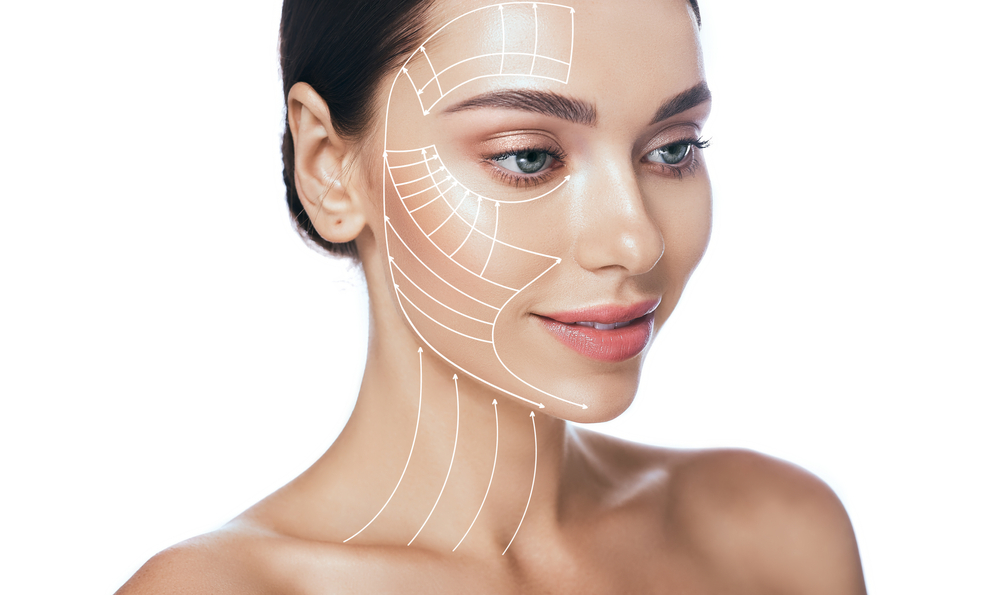Face Lift
Facial rejuvenation is a broad term to describe multiple procedures that are designed to create a more youthful, rested appearance to the normal aging face. Typically surgical maneuvers, such as a Facelift, are designed to remove excess sagging skin, elevate sagging jowls and cheeks, and, to some degree, remove wrinkles. Improvements in the neck, jowl, and cheek skin are most typically achieved with facelifting techniques which can vary depending on the severity and the intended improvements sought.
There is no one standard way to do a Facelift although there are some common elements in all techniques. The standard Facelift involves the incisions created typically in front of the ear and extended behind the ear and into the scalp. A more limited incision surgery such as a mini Facelift or a MACS lift involves smaller incisions sometimes limited to in front of the ear and temporal scalp. They all involved some degree of elevating the skin off of the underlying thin muscular layer, some degree of manipulation of that muscular layer, and removal of excess skin. Cheek and jowl skin is removed and elevated through incisions in the preauricular and temporal scalp regions while the neck skin is removed primarily behind the ear. Modifications of this approach such as a mini Facelift are designed to address primarily cheek and jowl and are best utilized when neck laxity is not significant. A standard facelift involves rejuvenation of the neck and a neck lift is considered part of that procedure. This procedure often involves an incision under the chin, removal of excess fat, tightening of divergent muscles in the neck and removal of excess skin. Adjuncts to facial rejuvenation include fat grafting, chemical peeling, laser peeling, and sometimes lip augmentation. Additional procedures are frequently added to a facelift to rejuvenate the entire face, most commonly upper Blepharoplasty, lower Blepharoplasty and often brow rejuvenation, such as a brow lift or temporal brow lift. Each patient is assessed individually for their desires and surgical needs.

The Procedure
Facelifts are usually performed in our on-site surgical center under a general anesthetic although sometimes sedation techniques can also be utilized. The procedure can last from 2-5 hours and sometimes longer if additional procedures such as Blepharoplasty or browlift are added. The plastic surgeon utilizes meticulous surgical technique to hide the resulting scars and judiciously remove excess tissue and sagging underlying facial muscle to achieve a natural rejuvenation. Avoidance of excess traction and pulling on the skin is desired to prevent thick noticeable scars and an obviously facelifted appearance. Delicate suturing is performed in front of the ear and behind the ear with the use of a drainage tube often required. Bleeding is carefully controlled and postoperative lightly compressive dressings are placed to limit swelling and provide for comfort.
The Recovery
It generally takes at least 2 weeks to recover from a Facelift to the point where you would feel comfortable going out in public for daily activities. Expect to heal closer to 4 weeks before you would feel comfortable going to a social event. This does vary depending on the severity of the deformity, age of the patient, and other associated procedures. Fro all Facelift surgeries, however, there will be some degree of swelling, bruising, and visible sutures for the first 10-14 days. Pain is usually not significant and easily managed with mild analgesics. Discomfort is primarily due to maintaining an upright position in bed and the nuisance of having to wear dressings. Most patients are seen 2 or 3 times in the first 2 weeks to remove sutures in a sequential fashion and monitor healing. Subsequent visits are stretched out over the next 3-4 weeks. Results are notable immediately however swelling and bruising must subside before an assessment of the final result is made. Complications of this procedure are generally minor and may involve some areas of delayed wound healing, bruising, and hematoma potentially. Facial nerve injury is rare but may involve a temporary weakness on one side of the face. Permanent weakness is extremely rare.
FAQ
Q: What is a minifacelift?
A: The mini Facelift, over short scar Facelift, usually involves treatment of the jowl and cheek area through limited incisions just in front of the ear and into the hairline with only minimal or no extension behind the ear. They are not used when there is significant laxity of the neck.
Q: At what age should I be thinking about a facelift?
A: The average woman who seeks face lifting is approximately 55-60 years old, although this ranges quite a bit. Some people develop facial aging signs in the 30’s and seek more minimal procedures. Others tolerate the natural aging process longer but seek improvements in the early 60’s. The filler agents, Botox, lasers, Thermage, and other less invasive procedures may be utilized to overcome early signs of aging and put off face lifting until a later date.



